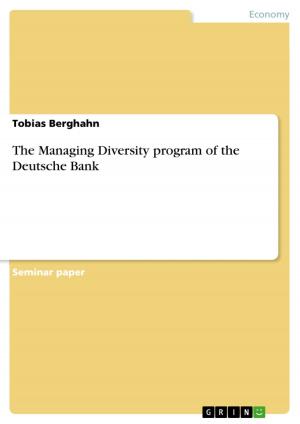Managing Diversity
Equality and Diversity within the Workplace
Business & Finance, Management & Leadership, Management| Author: | Iryna Shakhray | ISBN: | 9783640241620 |
| Publisher: | GRIN Publishing | Publication: | January 13, 2009 |
| Imprint: | GRIN Publishing | Language: | English |
| Author: | Iryna Shakhray |
| ISBN: | 9783640241620 |
| Publisher: | GRIN Publishing |
| Publication: | January 13, 2009 |
| Imprint: | GRIN Publishing |
| Language: | English |
Essay from the year 2008 in the subject Business economics - Business Management, Corporate Governance, grade: keine, University of Derby (University), course: Equality and Diversity within the Workplace (HRM), 5 entries in the bibliography, language: English, abstract: All people are different. Price (2004) states that they vary in their gender, culture, race, social and psychological characteristics. Our attitude towards these differences can be positive as well as negative; it depends usually upon individual perspectives and prejudices and sometimes even on influence of friends, accountancies and colleagues. There is a tendency to form like-minded groups, to recruit people like themselves. This may seem natural or normal and often goes unquestioned -but it is unfair. The consequences can be seen in a lack of opportunity for women, ethnic minorities, and disabled, the middle-aged and other disadvantaged sections of the community. People are the key assets of a business, according to Price (2004) so it is important to realise the maximum benefit from their human capital. True competitive advantage requires the best from everyone, without restrictions; it demands a prejudice-free attitude towards actual and potential employees. It requires diversity. So, what is diversity? Diversity, according to the Webster College Dictionary (in Grant and Kleiner 1997), is defined as [a] quality, state, fact, of instance of being diverse; different. The traditional definition of diversity is focused on gender and racial differences. In today's terms diversity also includes age, sexual preferences and disabilities; it could be defined by an individuals' different personal and corporate background, education, job function, tenure with the organisation, exempt or non-exempt status, and management or non-management. In the workplace today not only does diversity imply difference in people based on their identification with various groups, but it is also a process of acknowledging differences through action. In accordance to ASUO Multicultural Advocate (1999), the concept of diversity encompasses acceptance and respect. It means understanding that each individual is unique, and recognizing our individual differences. These can be along the dimensions of race, ethnicity, gender, sexual orientation, socio-economic status, age, physical abilities, religious beliefs, political beliefs, or other ideologies. It is the exploration of these differences in a safe, positive, and nurturing environment. (...)
Essay from the year 2008 in the subject Business economics - Business Management, Corporate Governance, grade: keine, University of Derby (University), course: Equality and Diversity within the Workplace (HRM), 5 entries in the bibliography, language: English, abstract: All people are different. Price (2004) states that they vary in their gender, culture, race, social and psychological characteristics. Our attitude towards these differences can be positive as well as negative; it depends usually upon individual perspectives and prejudices and sometimes even on influence of friends, accountancies and colleagues. There is a tendency to form like-minded groups, to recruit people like themselves. This may seem natural or normal and often goes unquestioned -but it is unfair. The consequences can be seen in a lack of opportunity for women, ethnic minorities, and disabled, the middle-aged and other disadvantaged sections of the community. People are the key assets of a business, according to Price (2004) so it is important to realise the maximum benefit from their human capital. True competitive advantage requires the best from everyone, without restrictions; it demands a prejudice-free attitude towards actual and potential employees. It requires diversity. So, what is diversity? Diversity, according to the Webster College Dictionary (in Grant and Kleiner 1997), is defined as [a] quality, state, fact, of instance of being diverse; different. The traditional definition of diversity is focused on gender and racial differences. In today's terms diversity also includes age, sexual preferences and disabilities; it could be defined by an individuals' different personal and corporate background, education, job function, tenure with the organisation, exempt or non-exempt status, and management or non-management. In the workplace today not only does diversity imply difference in people based on their identification with various groups, but it is also a process of acknowledging differences through action. In accordance to ASUO Multicultural Advocate (1999), the concept of diversity encompasses acceptance and respect. It means understanding that each individual is unique, and recognizing our individual differences. These can be along the dimensions of race, ethnicity, gender, sexual orientation, socio-economic status, age, physical abilities, religious beliefs, political beliefs, or other ideologies. It is the exploration of these differences in a safe, positive, and nurturing environment. (...)















